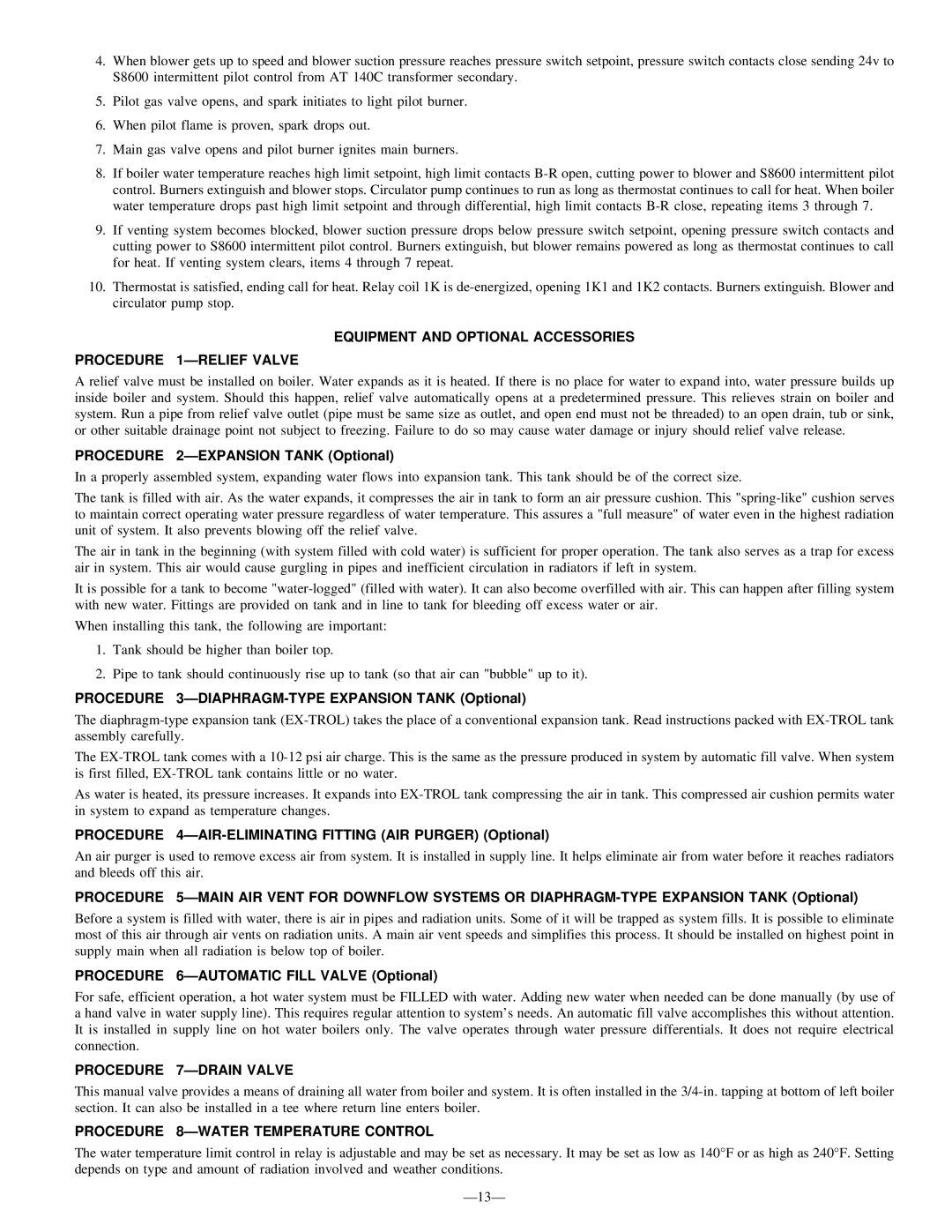4.When blower gets up to speed and blower suction pressure reaches pressure switch setpoint, pressure switch contacts close sending 24v to S8600 intermittent pilot control from AT 140C transformer secondary.
5.Pilot gas valve opens, and spark initiates to light pilot burner.
6.When pilot flame is proven, spark drops out.
7.Main gas valve opens and pilot burner ignites main burners.
8.If boiler water temperature reaches high limit setpoint, high limit contacts B-R open, cutting power to blower and S8600 intermittent pilot control. Burners extinguish and blower stops. Circulator pump continues to run as long as thermostat continues to call for heat. When boiler water temperature drops past high limit setpoint and through differential, high limit contacts B-R close, repeating items 3 through 7.
9.If venting system becomes blocked, blower suction pressure drops below pressure switch setpoint, opening pressure switch contacts and cutting power to S8600 intermittent pilot control. Burners extinguish, but blower remains powered as long as thermostat continues to call for heat. If venting system clears, items 4 through 7 repeat.
10.Thermostat is satisfied, ending call for heat. Relay coil 1K is de-energized, opening 1K1 and 1K2 contacts. Burners extinguish. Blower and circulator pump stop.
EQUIPMENT AND OPTIONAL ACCESSORIES
PROCEDURE 1ÐRELIEF VALVE
A relief valve must be installed on boiler. Water expands as it is heated. If there is no place for water to expand into, water pressure builds up inside boiler and system. Should this happen, relief valve automatically opens at a predetermined pressure. This relieves strain on boiler and system. Run a pipe from relief valve outlet (pipe must be same size as outlet, and open end must not be threaded) to an open drain, tub or sink, or other suitable drainage point not subject to freezing. Failure to do so may cause water damage or injury should relief valve release.
PROCEDURE 2ÐEXPANSION TANK (Optional)
In a properly assembled system, expanding water flows into expansion tank. This tank should be of the correct size.
The tank is filled with air. As the water expands, it compresses the air in tank to form an air pressure cushion. This "spring-like" cushion serves to maintain correct operating water pressure regardless of water temperature. This assures a "full measure" of water even in the highest radiation unit of system. It also prevents blowing off the relief valve.
The air in tank in the beginning (with system filled with cold water) is sufficient for proper operation. The tank also serves as a trap for excess air in system. This air would cause gurgling in pipes and inefficient circulation in radiators if left in system.
It is possible for a tank to become "water-logged" (filled with water). It can also become overfilled with air. This can happen after filling system with new water. Fittings are provided on tank and in line to tank for bleeding off excess water or air.
When installing this tank, the following are important:
1.Tank should be higher than boiler top.
2.Pipe to tank should continuously rise up to tank (so that air can "bubble" up to it).
PROCEDURE 3ÐDIAPHRAGM-TYPE EXPANSION TANK (Optional)
The diaphragm-type expansion tank (EX-TROL) takes the place of a conventional expansion tank. Read instructions packed with EX-TROL tank assembly carefully.
The EX-TROL tank comes with a 10-12 psi air charge. This is the same as the pressure produced in system by automatic fill valve. When system is first filled, EX-TROL tank contains little or no water.
As water is heated, its pressure increases. It expands into EX-TROL tank compressing the air in tank. This compressed air cushion permits water in system to expand as temperature changes.
PROCEDURE 4ÐAIR-ELIMINATING FITTING (AIR PURGER) (Optional)
An air purger is used to remove excess air from system. It is installed in supply line. It helps eliminate air from water before it reaches radiators and bleeds off this air.
PROCEDURE 5ÐMAIN AIR VENT FOR DOWNFLOW SYSTEMS OR DIAPHRAGM-TYPE EXPANSION TANK (Optional)
Before a system is filled with water, there is air in pipes and radiation units. Some of it will be trapped as system fills. It is possible to eliminate most of this air through air vents on radiation units. A main air vent speeds and simplifies this process. It should be installed on highest point in supply main when all radiation is below top of boiler.
PROCEDURE 6ÐAUTOMATIC FILL VALVE (Optional)
For safe, efficient operation, a hot water system must be FILLED with water. Adding new water when needed can be done manually (by use of a hand valve in water supply line). This requires regular attention to system's needs. An automatic fill valve accomplishes this without attention. It is installed in supply line on hot water boilers only. The valve operates through water pressure differentials. It does not require electrical connection.
PROCEDURE 7ÐDRAIN VALVE
This manual valve provides a means of draining all water from boiler and system. It is often installed in the 3/4-in. tapping at bottom of left boiler section. It can also be installed in a tee where return line enters boiler.
PROCEDURE 8ÐWATER TEMPERATURE CONTROL
The water temperature limit control in relay is adjustable and may be set as necessary. It may be set as low as 140°F or as high as 240°F. Setting depends on type and amount of radiation involved and weather conditions.
Ð13Ð
